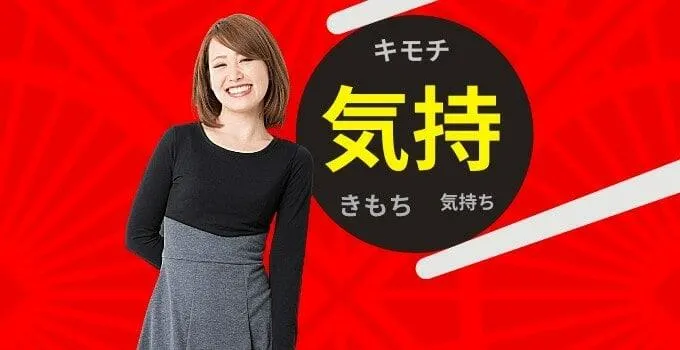If you’re familiar at all with Japanese media, you’ve probably encountered the word kimochi quite a few times and in quite a few different contexts.
In fact, you may have even heard it and not realized it, as it’s morphed into some slang forms as well.
In this article we’ll cover the basic meaning, as well as dive into the characters a bit, and see how it’s used in various ways.
But let’s start at the beginning—what does kimochi mean?
What is the meaning of kimochi in Japanese?
Kimochi is a “feeling.” This type of feeling is usually one brought on by some stimulation and is something of a non-persisting state of feeling. Kimochii (with a long -ii sound) means “good feeling.”
The characters in kimochi
Kimochi can be written a few ways in Japanese. First, there’s all hiragana: きもち. Then we have all katakana: キモチ. These are straightforward, one-to-one connections between sound and syllable.
Then, we can write it with a mix of hiragana and kanji (Chinese characters) as 気持ち, or even as pure kanji just by dropping that last character to make 気持.
The meaning of this word is all being held up in those two kanji characters.
So, let’s break them down.
The first character is 気. This is actually a newer form of a far older character (more than two thousand years old!) that comes direct from China, 氣.
There are some other ways it has been written throughout history, but we’re going to stick to these two main versions today.
This character has a pretty interesting etymology. 気 belongs to a category of characters known as phono-semantic compound characters.
What that means is that inside this little kanji there are hints to both is phonetic nature, as well as its meaning.
The phonetic component is 气, supposedly an abstraction of breath as visible on a cold day.
This 气 character can be pronounced “ki” as well.
But, to top it off, because it’s a picture of breath, we get an incidental bit of semantic meaning as well. 气 means “spirit,” or sometimes “steam.”
米 is the character for rice. Rice, being one of the most important foodstuffs in Asia, is also synonymous with being the “spirit” of life itself. So, we combine the breath of life 气 with the food of life 米 and we end up with 氣.
Beyond that, you can even imagine the 气 (steam) rising off the cooked 米 (rice).
The complicated 氣 character was then simplified to its modern 気 form. Today it carries many meanings, namely air, spirit, feeling, mood, sense, etc.
The second character is 持. This one also comes from China, but hasn’t changed much since ancient times.
Similarly to the previous character, it’s also a phono-semantic kanji (most kanji are).
It’s not immediately obvious how it all fits together due to the morphing of some base parts.
The phonetic component is on the right: 寺. This character means “temple,” but has no inherent meaning in 持; it merely provided a hint to the pronunciation.
The left side is a squished手, which means “hand.” So, it means to have something in hand, i.e. to hold something.
Putting the parts together
Together, we have the idea of spirit held in the connection of 気 and 持 to make kimochi.
So, it’s a feeling, a mood, or a sensation that you’re holding onto. Let that guide you when you think of how to use the expression.
It’s not something permanent, nor is it something wholly beyond your control, but rather something you are temporarily engaging with, aka “holding.”
Now that we are familiar with the base term, let’s see how it interacts with other words and parts of speech.
Kimochi in context
“Kimochi” is most often used in Japan for something that feels good. The most direct translation of it would be a relaxed and content sigh of “ahhhh” in English.
Sinking into a hot bath or onsen is kimochi.
Getting a good back massage is kimochi.
Laying on the beach with the sun shining down on you is kimochi.
When you experience any of these things, let out a long and happy “kimochiiiii”. The last syllable is often extended in the case of ultra-relaxation!
Expressing yourself in Japan is not as common as in western countries, so take the opportunity to do so when available!
“Kimochi” lets the others around you know that you are happy and relaxed, and no one will ever give you a sideward glance when using it.
“Kimochi” or the extended “kimochiiiii” is very commonly used among friends, family, and co-workers in Japan.
A quick “warning” on the use of Kimochi
How to put this delicately? If anyone has indulged in some “private time” Japanese media, they may have heard “kimochi” used in a rather, uh, emphatic way.
“Kimochi-ii” (with a slight intonation change between the single “I” and the double “ii”) is not quite the same as the more appropriate “kimochi” or “kimochiiiiii”.
That “ii” means “good.” So it literally translates to “good feeling”. This is sometimes used in an adult sense- but not always. Context is important!
“Kimochi-ii” (気持ちいい) said aloud, and without any specifying qualifiers, can sound a bit, shall we say “over excited.”
You may also see/hear this word as kimochi-yoi. This introduces a new kanji character, 良, which means “good.”
Kimochiiiiiii (with an extended iiiii of the same tone) just means that you are relaxed and enjoying the feeling, and can be used in a regular setting like the bath or the sunshine.
You don’t need to worry about sounding strange when using the word kimochi or even kimochi-ii. Just as the English phrase “That feels great” can have varying levels of appropriateness depending on the situation, “kimochi” is a versatile word as well.
If you are worried about your meaning being misconstrued in a rather embarrassing way, however, you can surround it with a bit of context.
Examples: Kimochi in a sentence
Yoko, kimochi-ii des.
The sunshine feels good.
朝の散歩ほど気持ちいいものはない。
Asa-no-sanpo hodo kimochi-ii mono wa nai.
Nothing is as pleasant as a walk in the morning.
とても暖かくて気持ちい良い。
Totemo atatakakute kimochi-yoi.
It’s nice and warm.
That said, if you find yourself in the happy embrace of a skilled paramour, feel free to let loose with a throaty “kimochi-ii” just like you’ve heard before—no extra context necessary.
It’s a normal part of the emphatic discourse of intimate relations in Japanese.
I hope that was sufficiently obfuscated by overly polite English to avoid offending anyone, and clear enough to be understood!
Kimochi warui
The exact flip side of kimochi-ii is kimochi-warui. This one gets written with the kanji 悪 to create 気持ち悪い.
This word has no hidden traps, so feel free to use it at will. Keep in mind that this doesn’t just mean “bad feeling,” but very often carries a feeling of “grossness.”
Feel a shiver run up your spine? Kimochi-warui. See a greasy otaku? Kimochi-warui. Spider crawls on you? 気持ち悪い!
It’s important to emphasize that this is a very rude phrase to use toward a person.
You may hear it during bullying scenes or whispered gossip scenes in anime or games, but these are meant to be shockingly rude.
It’s a word used for slimey, gross, greasy, yucky things. It shouldn’t be used for people!
While in English you may joke and say “Eww you’re so gross!”, you shouldn’t joke around with “kimochi warui” directed toward a person.
Kimochi warui turned slang: Kimoi
Kimochi warui also has a more “slangy” version, where the sounds have been compressed down into something shorter and, perhaps, easier to say.
If you want to get your point across in a more casual way, you can say kimoi, which is written as キモい.
You’ll notice that I wrote kimoi in katakana, and that’s because it’s an unusual, slangy word. You can write it in hiragana as well, though. That said, due to it being slang, you’ll want to reserve this strictly for informal uses.
Also, this word seems to carry an even stronger feeling of “creepy” or “gross,” over the full kimochi-warui version which can encompass “bad feelings” of many kinds. Kimoi is a strong word, so be careful.
Here are some example sentences:
Examples: Kimochi warui in a sentence
Watashi-no-kao ni dare-ka-no-iki ga kakatte, kimochi-warui wa.
Somebody’s breathing on my face. It’s disgusting.
いやな匂いで私気持ち悪くなった。
Iya-na nioi de watashi kimochi-warukunatta.
The bad smell sickened me.
なんかそれ、ブヨブヨしていて気持ち悪いね。
Nanka-sore, buyobuyo-shiteite kimochi-warui ne.
Oooh, sick! What is that stuff? It’s all spongy.
超気持ち悪い。戻しそう。
Chō kimochi warui. Modoshi sō.
I feel super sick. I might throw up.
彼はキモい
kara wa kimoi.
He’s disgusting.
Don’t get it confused!
Another word can sometimes be confused with kimochi. And that’s kibun written as 気分. That second character 分 means “part.”
Kibun is a condition. Think “mood” or even a medical condition. It’s a partition of your spirit, an active part of you, as opposed to something external that you’re “holding” on to. Make sense?
Some last notes on kimochi
There’s a lot of variation possible here, and I want you to keep that in mind. Don’t become dogmatic about anything you learn in Japanese—the language changes frequently and intensely. That’s part of its beauty.
One example we can return to is kimochi-ii. This can also be expressed as kimochi-ga-ii (気持ちがいい). Alternatively, you could say ii-kimochi (いい気持ち) and convey the same feeling.
There’s also other words you’ll hear/see that can be translated into “feeling.” Kanji, kigen, kanjo, etc.
As you wrap these into your awareness of Japanese, make sure to understand their contextual usage through example sentences and the nature of the kanji used.
Frequently asked questions about Kimochi
What does ike ike kimochi mean?
You may be slightly mishearing someone in the throes of passion. Basically, this means that the person speaking is reaching a, uh, climatic moment. This is derived from いく (iku), meaning “to go” or “to come” someplace. So, the person speaking is declaring that they are doing as such. I’ll, uh, let you extrapolate from there.
Is yabai a bad word?
Nah, it’s not a bad word, though it is slang. It’s a tough to accurately translate word, but it expresses that something is intense. It carries the sort of vague meaning, like “crazy” might in English. Yabai might mean “cool!” or even “terrible!” You’ll need to use context clues to suss it out yourself.
What does yamete mean?
Yamete is a command meaning “Stop!”

“I’ve lived in Japan on-and-off for the last five years, travelling to (almost) every corner of the Land of the Rising sun. I’ve deepened my love of the language with big hauls from Sapporo book stores, by chatting in Shinjuku coffee shops, drinking in Osaka “snack bars,” exploring distant Okinawan islands, and hitching rides with monks in Aomori. Japanese is a wide and deep language, and I’m always eager to dive in deeper.”

